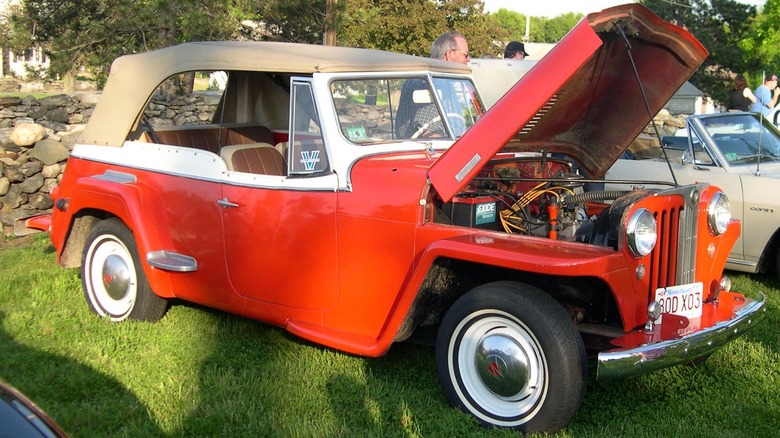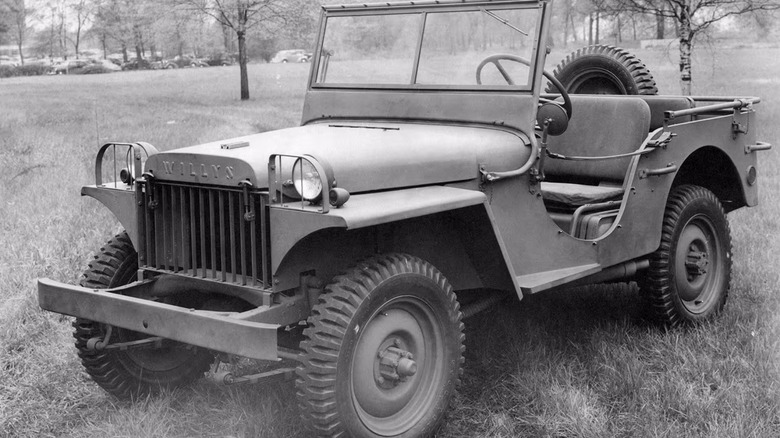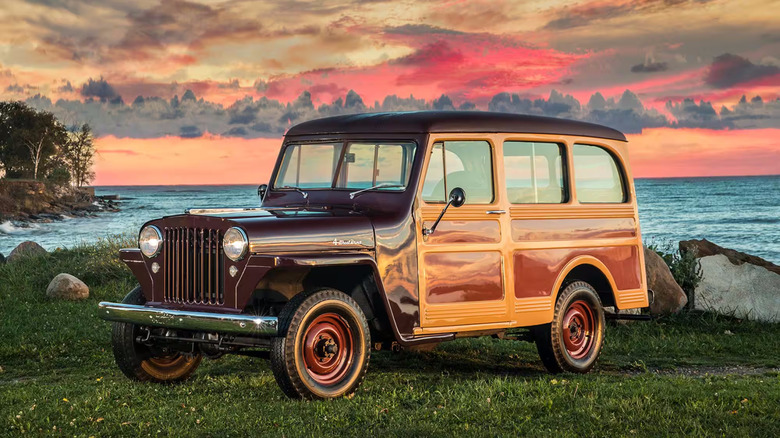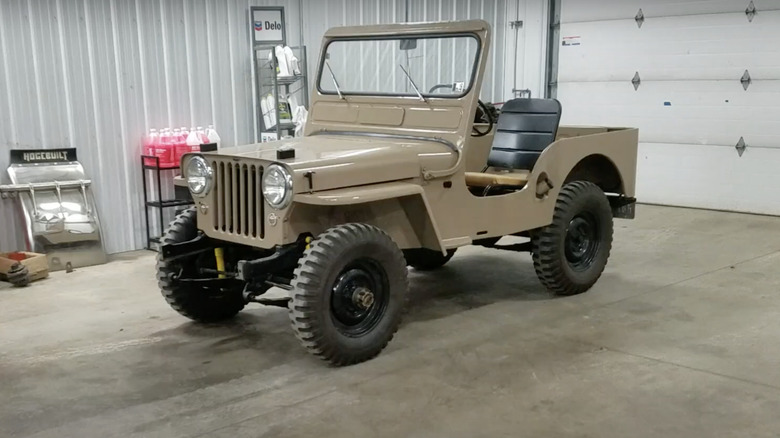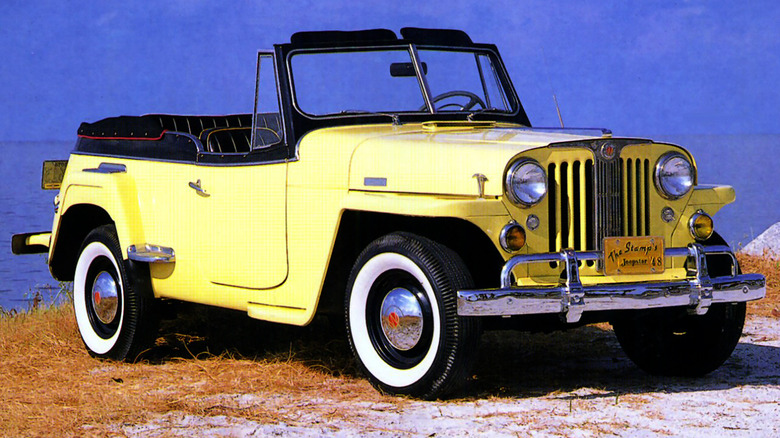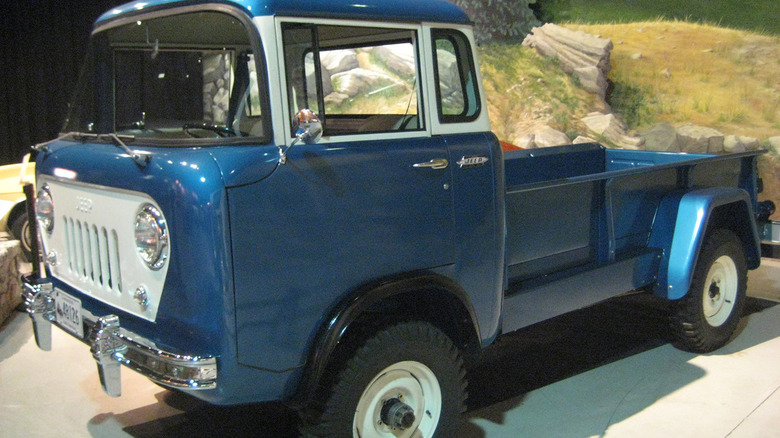5 Of The Rarest Jeep Willys Models (And How Much They're Worth Today)
Jeeps have been around since Willys Overland built its light troop and gear carrier for the U.S. Army during World War II. Immediately after the war, WIllys started the CJ (Civilian Jeep) line, which came to include the CJ-5 and CJ-7 once the Jeep brand had become the property of Kaiser Manufacturing, and then American Motors. AMC was responsible for creating the CJ8 Scrambler, which was produced in much smaller numbers than the CJ5 and CJ7. Scramblers are hard to find, and can command more than $50,000 in prime condition.
They're still more common than some of the Willys-era Jeeps, which run from 1945 through 1963. Kaiser purchased Willys in 1953, and rechristened the brand as Kaiser-Jeep ten years later. AMC bought Kaiser in 1969, and was in turn purchased by Chrysler in 1987. The 1945-1963 Willys models remain especially prized by collectors, and many of them have grown to be as or more valuable as AMC's CJ-8 Scrambler. Over the years, there have been a number of novelty Jeeps that cost a pretty penny. Let's highlight a few of the rarest and most valuable Willys Jeeps.
[Featured image by Stephen Foskett via Wikimedia Commons|Cropped and scaled|CC-By 3.0]
MA
It will come as no surprise to learn that the original Jeep Willys built for the Army is now one of its rarest models more than eight decades after it was born. After building two prototype 'Quads' in 1940, Willys incorporated feedback from the Army and added a hand brake, column shifter, and the rounded door cutouts that would later become a CJ design signature. The MA that reflected these updates remains the rarest of all pre-production Willys Jeeps, with 1,553 made in the Summer of 1941 and most going to Russia and England for wartime use. Only about 30 examples have survived the war and intervening years.
The extreme rarity of the MA makes it hard to place a value on this model, but if you can locate one of the rare remaining specimens, expect to pay at least $60,000 to putter home in it. Our best advice is to load it onto a trailer — the four-cylinder "Go-Devil" engine in the MA produced just 60 hp and 105 lb-ft of torque and the top speed of the MA is a modest 65 mph.
Wagon
After the war ended, Willlys morphed the MA and its MB successor into the CJ-2A, which was marketed to farmers and construction workers as a do-anything utility vehicle. In 1946, Willys introduced the Wagon, which had an all-steel body despite looking like it featured wood-grain panels on the sides. This effect was achieved by using three different shades of paint instead of wood cladding like other vehicles. This lent the Willys Wagon an element of durability and cut down on annoying squeaks and rattles. The upright body with two-piece rear gate and glass was designed by Brooks Stevens, and the rear seats were removable to make room for more cargo.
A four-wheel drive version appeared in 1949, and the Go-Devil I4 gave way to the F-134 Hurricane and a 161 cubic inch six-cylinder the following year. The Willys Wagon stayed in production through 1965, and wasn't rare in its day with a production run of over 300,000 units in various body styles. They're hard to find today, though. Only ten are currently listed for sale, and the 67 that have changed hands in the last five years went for an average of just over $25,000. The cheapest was a project condition 1962 model that sold in 2019 for $4,950 and the most expensive was a meticulously restored 1960 green specimen with the wood-grain paint that fetched $82,500 in 2021.
CJ3A
The CJ line started in 1945 with the CJ-2A, in production through 1949. Late the year before, Willys unveiled the CJ-3A, which saw a few refinements and design changes. The two-piece windshield was swapped out for a single-pane unit, and the wipers were moved from the top to the bottom. The transmission, transfer case, and rear axle were upgraded, but the L-head Go-Devil four-cylinder engine remained under the flat hood. Ergonomic improvements included more leg room, better weather sealing on the canvas top and doors, and thicker seat cushions. The CJ-3A was still marketed almost exclusively as a farm vehicle, but Willys sold more than 130,000 during its four-year run from 1949 through 1953.
The years have taken a toll on the supply of CJ-3As, though. We could only find two currently for sale: a 1949 in Pennsylvania for $25,900, and a 1951 in Illinois for $31,000. Only 20 have sold in the last five years, going for an average of a little under $18,000.
Jeepster
The VJ Jeepster was an anomaly among the Willys lineup. It was introduced in 1948 and was intended to slot into the affordable end of the sports car segment. But at $1,900 it was almost $500 more expensive than the average car, and with the base 62 hp Go-Devil engine, it took almost half a minute to get from zero to 60 mph. Unlike other Willys models, the Jeepster was only offered with rear-wheel drive, although it shared a rear axle and suspension design with the Wagon. In 1949, the Jeepster was offered with the six-cylinder, 148-inch 'Lightning' engine, and for 1950 engine options included the 134-inch 'Hurricane' I4 and a 161-inch straight six that was made available mid-year.
The Jeepster carried on until 1951, but models sold that year were leftovers from 1950. Production totaled less than 20,000 units for the Jeepster's entire run. The style was resurrected by Kaiser in 1966 as the Commando, however. Considering the minuscule production run, Willys Jeepsters are surprisingly easy to find. We found a dozen current listings at prices ranging from $17,500 to just under $30,000. In the last five years, more than 130 have been sold at an average price of a little over $22,000.
[Featured image by Mashley Morgan via Wikimedia Commons|Cropped and scaled|CC-By 2.0]
FC
Another of Willys' rarest models was undoubtedly one of its quirkiest. The FC (Forward Control)-150 was introduced late in 1956 as a 1957 model, and the FC-170 came the following May. Like the Wagon and Jeepster, the FC was designed by Brooks Stevens. The 1/2-ton FC-150 had an 81-inch wheelbase and 74-inch bed, and the 1-ton FC-170 sat on a 103.5-inch) wheelbase and had a 108-inch bed. Unlike the Jeepster, the FC had four-wheel drive as standard equipment, and it initially shared its four-cylinder F-134 engine with other Willys models. Early FC-150s had a three-speed manual transmission coupled to a Spicer 18 transfer case and sat on Spicer 25 front and Dana 44 rear axles. The FC-170 was wider and longer, with a 57-inch track as opposed to the FC-150's 48.4 inches.
Willys made 6,637 1957 FCs, but lackluster sales forced a decline in production numbers in the following years. The last one rolled off the line in December of 1964 as a 1965 model, at which point production had totaled a little over 16,000 units. They're currently among the hardest to find of any Willys model — we were only able to find four current listings, all in the $32,000-$33,000 range. Only 24 have sold over the past five years, for an average of $33,253.
[Featured image by John Lloyd via Wikimedia Commons|Cropped and scaled|CC-By 2.0]
